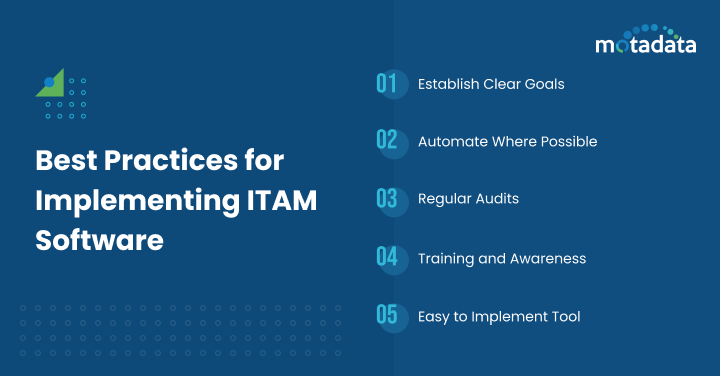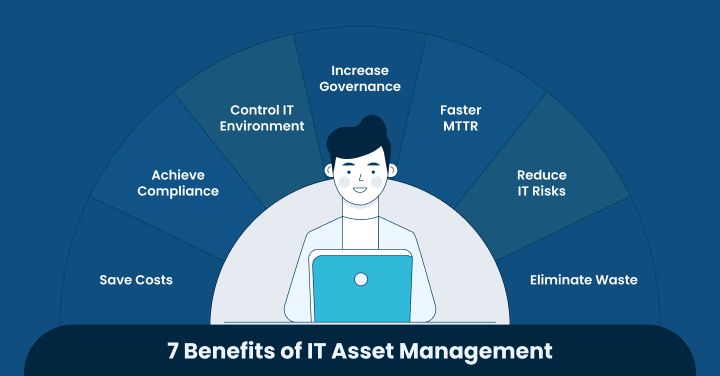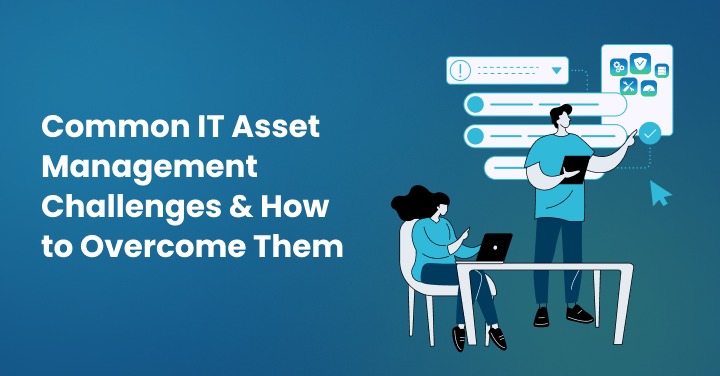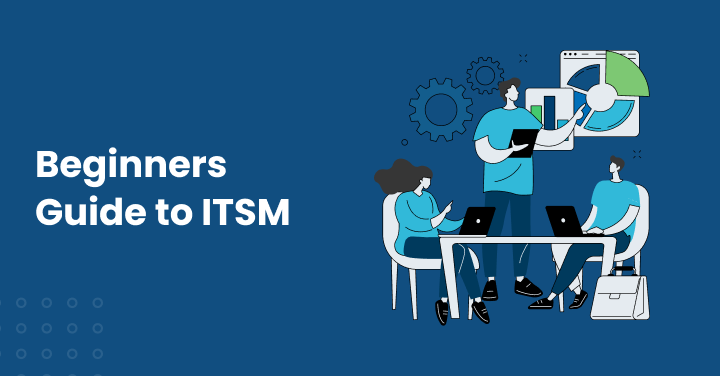In today’s rapidly evolving digital landscape, businesses must prioritize compliance and security to protect sensitive information and ensure smooth operations.
An IT Asset Management (ITAM) solution is a vital tool in achieving these goals, enabling organizations to monitor, manage, and optimize their IT assets.
This software helps manage IT assets efficiently, from setup to deployment and upgrades.
This blog will explore how ITAM software is crucial in maintaining compliance with regulations and bolstering security efforts.
What is IT Asset Management, and Why is it required?
IT asset management (ITAM) involves tracking an organization’s hardware, software, and other technology assets, ensuring effective use throughout their lifecycle.
It starts with acquisition and ends with their disposal.
By managing assets well, organizations can maximize their IT investments, avoid overspending, and ensure resources are used efficiently.
But ITAM does more than just track equipment—it also helps align IT with business goals, ensuring technology complies with internal policies and external regulations.
In short, it allows organizations to stay organized, save money, and ensure their technology works for them, not vice versa.
Rated highly by Gartner, ITAM solutions offer comprehensive management for organizations of all sizes.
The Increasing Complexity of Compliance and Security Landscape
Organizations adopting new technologies and spreading their digital operations face various compliance and security challenges.
Regulatory frameworks such as GDPR (General Data Protection Regulation), HIPAA (Health Insurance Portability and Accountability Act), and PCI DSS (Payment Card Industry Data Security Standard) demand strict controls over how data is managed, stored, and protected.
These regulations vary from industry to industry and region to region, making it essential for businesses to monitor their assets to ensure compliance.
In addition to regulatory pressures, security risks are continuously sprouting.
Cyberattacks are becoming more sophisticated, with threats like ransomware, phishing, and data breaches posing significant risks to organizations.
Unpatched software, outdated hardware, and unsecured endpoints can become vulnerabilities, leading to data leaks, financial losses, and reputational damage.
How Does Asset Management Solution Address These Challenges?
Have you ever wondered how organizations can tackle growing compliance and security challenges effectively? The answer lies in asset management software.
By automating the tracking of IT assets, businesses gain real-time visibility into their hardware, software, and licenses.
This enhanced visibility ensures that records of asset ownership, location, and configuration are always up to date, which is essential for passing regulatory audits and preserving against theft.
But it doesn’t stop there. Asset management software also allows organizations to integrate with accounting software and proactively identify and mitigate security risks.
Automated patch management, lifecycle tracking, and software updates help minimize vulnerabilities, ensuring that assets remain secure and meet industry standards.
By consolidating all asset data into a single platform, ITAM streamlines IT infrastructure management, reduces human error, and ensures that no critical security or compliance task is overlooked.
It’s an all-encompassing solution to modern IT challenges.
Exploring the Evolving Compliance and Security Challenges in IT
How can businesses keep pace with the rapidly changing compliance and security landscape?
This is a concern not just for IT departments but also for organizations.
As technology advances, so do the complexities of maintaining security and adhering to regulations like GDPR, HIPAA, and PCI DSS.
The increasing use of cloud services, remote work, and reliance on third-party vendors introduce new challenges, making it harder to stay compliant.
At the same time, cybersecurity threats such as ransomware and data breaches grow more sophisticated, putting sensitive data and reputations at risk.
So, how can businesses address these challenges proactively?
It is crucial to stay ahead of regulatory changes while implementing strong security measures.
Organizations must ensure their IT assets are properly managed, networks are secure, and technology aligns with compliance and security standards.
The key challenge is to adjust to evolving risks while safeguarding critical assets across the entire IT infrastructure.
Key Compliance Regulations:
Compliance regulations like the General Data Protection Regulation (GDPR), Health Insurance Portability and Accountability Act (HIPAA), and Payment Card Industry Data Security Standard (PCI DSS) set rigorous standards for how organizations must manage, store, and protect sensitive data.
These rules are crucial for ensuring that personal, medical, and financial information remains secure and prevents misuse, unauthorized access, and potential breaches, especially in real time.
- GDPR is a European Union law that oversees the management of personal data. It mandates that businesses secure clear consent from individuals before using their data. It also grants individuals the right to access, correct, or erase their data, emphasizing the importance of privacy. Organizations that fail to comply with GDPR can face significant penalties, potentially reaching up to 4% of their global revenue.
- HIPAA governs healthcare organizations in the U.S., mandating the protection of patient health information. It establishes rigorous standards for securing data during transmission, storage, and access. Violations of HIPAA can result in substantial penalties and potential legal consequences.
- PCI DSS governs companies handling credit card transactions, ensuring payment information is securely processed, stored, and transmitted. Failure to comply with PCI DSS can result in financial penalties, reputation damage, and the loss of the ability to process credit card payments.
Non-compliance with these regulations can lead to severe fines, legal consequences, and lasting reputational damage, making adherence essential for businesses in regulated industries.
Security Threats and Vulnerabilities:
Security threats are growing more severe as cyberattacks become more advanced.
Critical threats include ransomware, which locks data and demands payment for restoration; phishing, where attackers deceive individuals into disclosing confidential information; and insider attacks, where trusted personnel abuse their access for harmful purposes.
Organizations commonly face vulnerabilities such as outdated software that misses critical security updates, unsecured devices prone to breaches, and misconfigured systems that may unintentionally expose sensitive information.
These vulnerabilities are prime targets for attackers aiming to exploit them, resulting in significant security breaches and compromised data.
Assets and Security Breaches:
IT assets such as servers, laptops, and mobile devices can become entry points for attackers if they are not adequately secured.
Unmanaged or inadequately managed assets often represent vulnerabilities in a company’s security framework.
For instance, outdated software, unpatched systems, and unsecured devices can be easily exploited by cybercriminals to gain unauthorized access.
These weak points can jeopardize sensitive data, leading to significant security breaches.
Ensuring that all IT assets are effectively monitored, updated, and protected is crucial for safeguarding against potential threats and maintaining the integrity of the organization’s data.
The Role of Asset Management
At its core, IT asset management software is designed to help organizations gain visibility into their IT environment.
It provides key functionalities that streamline asset tracking, ensure compliance, and support security protocols. It includes:
Asset Discovery and Inventory:
Asset Discovery and Inventory is a critical function of ITAM software that automatically scans and identifies all assets within an organization’s network.
It provides a detailed, real-time inventory of hardware, software, and licenses, ensuring that every asset is accounted for.
This feature enables organizations to maintain complete visibility over their IT environment, including asset locations, configurations, and ownership.
By offering access to a comprehensive asset history, the software helps prevent shadow IT—untracked devices or software that can introduce security risks.
ITAM software streamlines asset management, enhances security, and minimizes vulnerabilities by ensuring all assets are properly monitored and managed.
Asset Classification and Categorization:
Asset Classification and Categorization play a vital role in IT asset management by organizing assets based on their criticality, data sensitivity, and importance to business operations.
This process enables organizations to prioritize the protection of their most valuable assets.
High-value assets—those crucial to business continuity or holding sensitive information—can be fortified with advanced security measures, such as encryption and multi-factor authentication, reducing the risk of exposure or breaches.
Organizations can allocate resources efficiently, enhance security, and refine responses to potential threats by ensuring that each asset is classified appropriately, ultimately protecting their critical business functions.
Tracking Asset Lifecycle and Depreciation:
ITAM software allows organizations to track an asset’s entire lifecycle, from acquisition to disposal.
This ensures that outdated or underperforming assets are replaced or upgraded in a timely manner, preventing vulnerabilities caused by obsolete technologies.
Software License Management and Compliance:
Effective license management is crucial for maintaining regulatory compliance.
ITAM software helps organizations stay compliant by monitoring software usage, tracking license allocations, and ensuring that no unauthorized or unlicensed software is in use.
This reduces the risk of legal penalties, audits, or fines while preventing overspending on unnecessary licenses.
The software helps businesses optimize their software investments and avoid potential compliance breaches by providing real-time insights into license status and expiration dates.
In turn, this ensures smoother operations and enhances overall governance across the IT landscape.
Asset Management Tool for Compliance
Isn’t it crucial to maintain control over assets and ensure the right processes are in place for regulatory compliance?
Effective asset management software involves more than just tracking and managing assets; it also requires confirming that all procedures align with regulatory standards.
This ensures that organizations meet compliance requirements and avoid potential legal or financial repercussions.
Ensuring Compliance with Regulatory Requirements:
ITAM software helps align IT assets with the relevant regulatory standards, automatically flagging assets that may not comply with regulations like GDPR or HIPAA.
Auditing and Reporting Capabilities:
Built-in auditing and reporting tools allow businesses to generate reports for internal audits or external regulatory bodies, making proving compliance easier and avoiding costly fines.
Risk Assessment and Mitigation:
With continuous monitoring, ITAM software can assess risks associated with specific assets, enabling IT teams to address vulnerabilities before they become larger security or compliance concerns.
Managing Vendor and Third-Party Risks:
Many organizations rely on third-party vendors for hardware and software.
ITAM software provides oversight by ensuring third-party products meet compliance requirements and do not introduce hidden risks.
Data Privacy and Protection:
ITAM enables companies to map assets to the data they store or process, ensuring that personal data is adequately protected and proper access controls are in place.
Asset Management for Security
Isn’t security a primary focus of ITAM software, helping businesses protect their assets from both internal and external threats?
Effective asset management software plays a central role in protecting an organization’s IT infrastructure by identifying vulnerabilities, implementing robust security measures, and ensuring continuous monitoring to defend against potential threats.
Inventorying IT Assets for Vulnerability Management:
A comprehensive asset inventory is essential for maintaining robust security.
ITAM software helps security teams by identifying vulnerable assets, allowing them to prioritize patching and implement necessary security measures.
This proactive approach reduces the risk of cyber threats and strengthens the organization’s overall security posture.
Patch Management and Software Updates:
Outdated software is a common target for attackers.
ITAM integrates with patch management tools to ensure that all assets are regularly updated with the latest security patches, reducing vulnerability to exploits.
Asset Disposition and Data Erasure:
When assets reach the end of their lifecycle, ITAM software facilitates proper decommissioning processes, ensuring compliance with security protocols.
It manages secure data erasure, eliminating any residual sensitive information, thereby preventing potential data breaches or unauthorized access.
By automating these processes, the software ensures that no critical data is left behind, reducing risks associated with improper disposal of outdated or retired assets.
Incident Response and Recovery:
In a security breach, ITAM software can provide valuable insights into compromised assets, support incident response efforts, and help restore systems quickly.
Role in Cybersecurity Frameworks:
ITAM software aligns with many cybersecurity frameworks, such as the NIST Cybersecurity Framework and ISO 27001, helping businesses implement structured security measures and protect critical infrastructure.
Case Studies and Best Practices
Several organizations have successfully implemented ITAM software to address compliance and security challenges.
For example, companies in the healthcare sector use asset management software solutions to maintain HIPAA compliance by monitoring the use and distribution of patient data.
Similarly, financial institutions leverage asset management software to ensure their systems meet the stringent requirements of PCI DSS.
Best Practices for Implementing ITAM Software:
1. Establish Clear Goals:
Define what your organization aims to achieve with ITAM, improving security, enhancing compliance, or optimizing asset usage.
2. Automate Where Possible:
Leverage automation to minimize manual asset tracking and ensure real-time visibility into your IT environment.
With the help of advanced workflow capabilities and ticketing systems, you can streamline troubleshooting and address issues promptly.
3. Regular Audits:
Audit your assets regularly to ensure compliance and identify any security gaps.
Also, send notifications via email alerts or SMS for real-time updates on asset status.
4. Training and Awareness:
Ensure that all users and employees understand the importance of asset management software in protecting the organization’s data and complying with regulations.
5. Easy to Implement Tool:
Select an asset management software tool that is easy to understand and adaptable.
This will reduce the employees’ learning curve, making it easy for them to get hands-on smoothly.
Conclusion
IT asset management software is essential for organizations striving to balance compliance and security in an increasingly complex digital world.
By providing visibility, control, and automation over IT assets, businesses can protect their infrastructure, maintain regulatory compliance, and minimize security risks.
As the compliance and security landscape continues to evolve, implementing a comprehensive IT asset management software strategy is no longer optional—it’s a necessity.
Now is the time for organizations to invest in robust ITAM software to stay ahead of the curve and protect their most valuable assets.
Motadata ServiceOps Asset Manager software can be the ultimate solution to this.
With the ease of use and features like automatic asset discovery, purchase and contract management, hardware, software, non-IT asset, and consumable asset management, CMDB, Remote Desktop support, compliance management, audit and reports, asset transfer, and movement request, Barcode & QR code support, etc.
ServiceOps Asset Manager can track and manage all your assets efficiently.
Additionally, the software is accessible through both web and mobile (iOS & Android) apps, allowing users to interact with it seamlessly across different devices.
This makes our tool the best asset management software for addressing all your asset management needs.
Moreover, choosing the right piece of software ensures transparency in asset management software and top-notch customer service for ongoing technical support and satisfaction.
Do you want to explore how our ServiceOps Asset Manager software can help your organization achieve compliance and meet security goals?
Contact us today to learn more about our solutions!
FAQs:
ITAM refers to the process of tracking, managing, and optimizing an organization’s IT assets throughout their lifecycle, from procurement to disposal.
ITAM ensures organizations meet regulatory requirements by keeping accurate records of software licenses, hardware inventories, and asset configurations.
Standards like ISO 27001, GDPR, SOX, HIPAA, and PCI-DSS often require companies to maintain control over their IT assets for regulatory compliance.
ITAM provides visibility into the IT environment, helping organizations identify vulnerabilities, ensure timely software updates, and mitigate security risks.
ITAM provides detailed asset information, which helps IT teams respond quickly to security incidents and take preventive actions.









